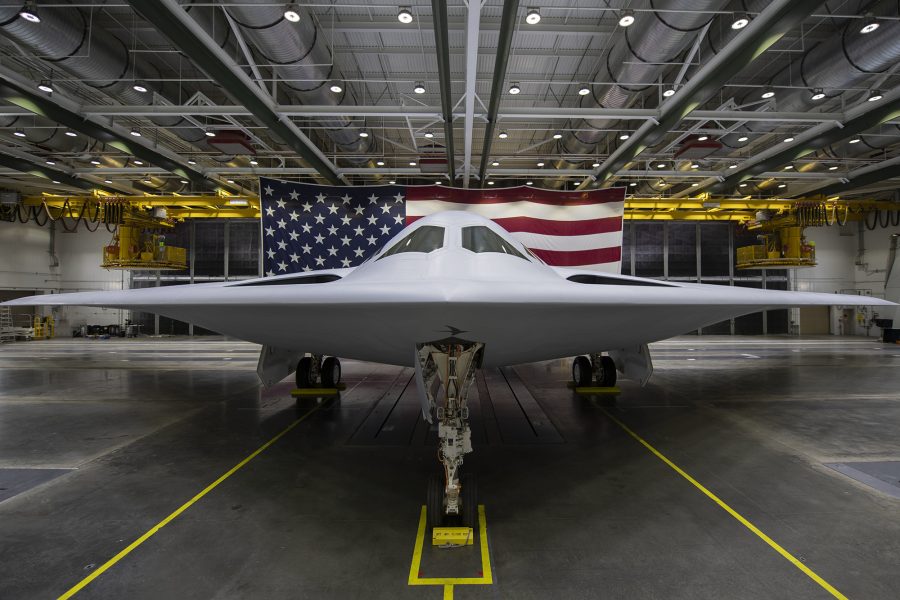Northrop Grumman announced a $1.56 billion pre-tax charge against its B-21 program, spread across the first five production lots of the new stealth bomber, the company announced during an earnings call Jan. 25. Company officials blamed inflation and supply chain problems for the loss, but said it might mitigate it over time with production line efficiencies.
After a review in the fourth quarter, “we now believe it is probable each of the first five LRIP (Low Rate Initial Production) lots will be performed at a loss,” Kathy Warden, Northrop’s president, chairman, and CEO said in a results call with reporters.
Though “disappointed” by the charge, Warden said she’s confident the B-21 will deliver what the Air Force requires of it.
“The charge is largely driven by a change in our assumptions” regarding inflation “and higher projected manufacturing costs,” based on information from suppliers and experience in competing the first aircraft, which rolled out in December 2022 and flew in November 2023.
Dave Keffer, corporate vice president and chief financial officer, said that with completion and first flight of the first B-21, “we have a lot more information than we did this time last year” about actual costs.
The “after-tax cash impact” of the loss will be spread over several years, Warden said. That amount is about $1.19 billion.
Warden also acknowledged that Northrop received the LRIP contract after the first flight; an action the Pentagon acknowledged last week. It also said the B-21 has flown more than once at Edwards Air Force Base, Calif., but is withholding developmental progress details due to operational security.
While the Pentagon provided $60 million of assistance in 2023 to help with higher-than-expected inflation, Warden noted, the company is not counting on any further such assistance, although discussions continue. The charge was therefore larger than Warden had been hinting at in previous earnings calls throughout 2023.
Keffer said the effect will be “an average of a couple of hundred million dollars a year of after-tax impact” on the B-21 program over about five years, after a higher amount in the earlier part of that period. The 2023 effect was a $143 million loss on B-21.
Offsets will be sought, he said.
It is a “core focus of our team to continue to drive efficiencies in the learning curves, [and in] successful outcomes of our negotiations with suppliers,” he said. “We continue to engage and partner with our customer to understand the macro-economic impacts on the program and address opportunities for funding relief, so we’ll continue to address all of those opportunities.”
The Air Force has not disclosed how many B-21s are included in the five LRIP lots, although the Congressional Research Service used 21 aircraft across those five lots as the notional figure for their assessment of the program in 2021.
The Air Force uses 2010 as the base year for calculating B-21 costs. The unit cost of one of the bombers was contractually set at $550 million in the original 2015 contract, which means that in current dollars, each B-21 must come in under $778 million. Northrop’s announcement indicates that if the five fixed-price lots comprise 21 aircraft, each one will cost $75 million more than predicted; a cost that Northrop must bear.
Warden also reiterated comments she made in previous quarterly calls that the company is being more careful in bidding fixed-price contracts, and may not bid on future programs if the “risk-reward calculation” isn’t compelling. The same sentiment was voiced on quarterly calls this week with Lockheed Martin and RTX, although Lockheed CEO Jim Taiclet said government is also clearly pushing fewer fixed-price programs.
The B-21 will eventually make money, Warden said.
“This is a game-changing capability that will be of great value to our nation. And we are focused on executing the program in a way that also delivers value to our shareholders over the coming decades,” she said.
The Air Force continues to say the B-21 program is aimed at producing “at least 100” aircraft, with the first usable asset available in “the mid-2020s.” But various think tanks, including the Mitchell Institute for Aerospace Studies—and former heads of Global Strike Command—have called for as many as 150-225 B-21s to maintain the pace of operations necessary to successfully conduct a war with a near-peer adversary like China.
Northrop is also the prime for the LGM-35A Sentinel ICBM program, which was reported by the Pentagon to Congress last week as having incurred a 37 percent cost increase and a two-year schedule delay. Warden echoed Air Force comments that the missile itself is developing well, but that the cost increases are largely due to higher costs for the military construction and communications infrastructure elements of the program, on which the Air Force takes more of the lead. Warden said Northrop will work with the Air Force to reduce Sentinel costs.
